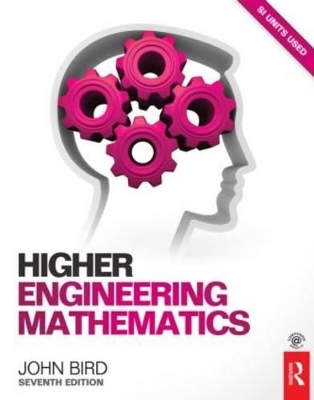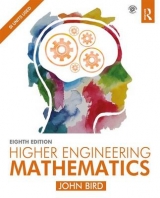
Higher Engineering Mathematics, 7th ed
Routledge (Verlag)
978-0-415-66282-6 (ISBN)
- Titel erscheint in neuer Auflage
- Artikel merken
John Bird’s approach to mathematics, based on numerous worked examples and interactive problems, is ideal for vocational students that require an advanced textbook.
Theory is kept to a minimum, with the emphasis firmly placed on problem-solving skills, making this a thoroughly practical introduction to the advanced mathematics engineering that students need to master. The extensive and thorough topic coverage makes this an ideal text for upper level vocational courses.
Now in its seventh edition, Engineering Mathematics has helped thousands of students to succeed in their exams. The new edition includes a section at the start of each chapter to explain why the content is important and how it relates to real life. It is also supported by a fully updated companion website with resources for both students and lecturers. It has full solutions to all 1900 further questions contained in the 269 practice exercises.
John Bird is the former head of Applied Electronics in the Faculty of Technology at Highbury College, Portsmouth, UK. More recently he has combined freelance lecturing at the University of Portsmouth with his Examiner responsibilities for Advanced Mathematics with City & Guilds. He is the author of over 125 textbooks on engineering and mathematical subjects, with worldwide sales of 1 million copies. He is currently a Senior Training Provider at the Defence School of Marine Engineering in the Defence College of Technical Training at HMS Sultan, Gosport, Hampshire, UK.
Introduction; Preface; Website information; Syllabus guidance; 1. Algebra; 2. Partial fractions; 3. Logarithms; 4. Exponential functions; 5. Inequalities; Revision Test 1; 6. Arithmetic and geometric progressions; 7. The binomial series; Revision Test 2; 8. Maclaurin’s series; 9. Solving equations by iterative methods; 10. Binary, octal and hexadecimal numbers; 11. Boolean algebra and logic circuits; Revision Test 3; 12. Introduction to trigonometry; 13. Cartesian and polar co-ordinates; 14. The circle and its properties; Revision Test 4; 15. Trigonometric waveforms; 16. Hyperbolic functions; 17. Trigonometric identities and equations; 18. The relationship between trigonometric and hyperbolic functions; 19. Compound angles; Revision Test 5; 20. Functions and their curves; 21. Irregular areas, volumes and mean values of waveforms; Revision Test 6; 22. Complex numbers; 23. De Moivre’s theorem; 24. The theory of matrices and determinants; 25. Applications of matrices and determinants; Revision Test 7; 26. Vectors; 27. Methods of adding alternating waveforms; 28. Scalar and vector products; Revision Test 8; 29. Methods of differentiation; 30. Some applications of differentiation; 31. Differentiation of parametric equations; 32. Differentiation of implicit functions; 33. Logarithmic differentiation; Revision Test 9; 34. Differentiation of hyperbolic functions; 35. Differentiation of inverse trigonometric and hyperbolic functions; 36. Partial differentiation; 37. Total differential, rates of change and small changes; 38. Maxima, minima and saddle points for functions of two variables; Revision Test 10; 39. Standard integration; 40. Some applications of integration; 41. Integration using algebraic substitutions; Revision Test 11; 42. Integration using trigonometric and hyperbolic substitutions; 43. Integration using partial fractions; 44. The t = tan substitution; Revision Test 12; 45. Integration by parts; 46. Reduction formulae; 47. Double and triple integrals; 48. Numerical integration; Revision Test 13; 49. Solution of first order differential equations by separation of variables; 50. Homogeneous first order differential equations; 51.Linear first order differential equations; 52. Numerical methods for first order differential equations; Revision Test 14; 53. First order differential equations of the form; 54. First order differential equations of the form; 55. Power series methods of solving ordinary differential equations; 56. An introduction to partial differential equations; Revision Test 15; 57. Presentation of statistical data; 58. Mean, median, mode and standard deviation; 59. Probability; Revision Test 16; 60. The binomial and Poisson distributions; 61. The normal distribution; 62. Linear correlation; 63. Linear regression; Revision Test 17; 64. Sampling and estimation theories; 65. Significance testing; 66. Chi-square and distribution-free tests; Revision Test 18; 67. Introduction to Laplace transforms; 68. Properties of Laplace transforms; 69. Inverse Laplace transforms; 70. The Laplace transform of the Heaviside function; 71. The solution of differential equations using Laplace transforms; 72. The solution of simultaneous differential equations using Laplace transforms; Revision Test 19; 73. Fourier series for periodic functions of period 2p; 74. Fourier series for a non-periodic function over period 2p; 75. Even and odd functions and half-range Fourier series ; 76. Fourier series over any range; 77. A numerical method of harmonic analysis; 78. The complex or exponential form of a Fourier series; Revision Test 20; Essential formulae; Answers to Practise Exercises; Index
| Zusatzinfo | 251 Tables, black and white; 559 Illustrations, black and white |
|---|---|
| Verlagsort | London |
| Sprache | englisch |
| Maße | 219 x 276 mm |
| Gewicht | 2790 g |
| Themenwelt | Schulbuch / Wörterbuch |
| Mathematik / Informatik ► Mathematik ► Angewandte Mathematik | |
| Technik | |
| ISBN-10 | 0-415-66282-6 / 0415662826 |
| ISBN-13 | 978-0-415-66282-6 / 9780415662826 |
| Zustand | Neuware |
| Haben Sie eine Frage zum Produkt? |
aus dem Bereich



